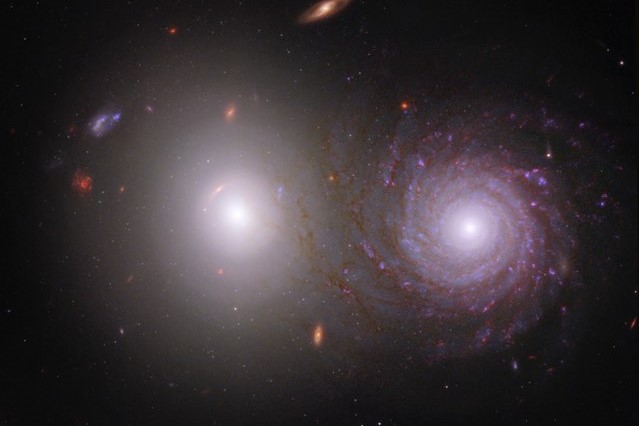
Scientists have made a groundbreaking discovery in the field of astronomy. A recent study identified the earliest instances of intricate organic compounds ever detected in the vast expanse of the universe.
These particular substances resemble the ones commonly found in smoke and soot right here on our own planet. Surprisingly, they exist within a young galaxy that took shape when the universe was merely at a tenth of its present age.
The complex carbon-based molecules, officially referred to as polycyclic aromatic hydrocarbons, can be found in deposits of oil and coal on Earth, as well as in the hazy air pollution known as smog.
The study lead author Justin Spilker, and an astronomer at Texas A&M University in College Station said, “The molecules we found aren’t simple things like water or carbon dioxide.” He said, “We’re talking about big, floppy molecules with dozens or hundreds of atoms in them.”
Study of organic molecules for better insights into the galaxies’ activities
Complex organic molecules are quite prevalent in outer space and are often associated with tiny dust particles. Astronomers study these molecules because they provide valuable insights into the activities occurring within galaxies.
For example, they play a role in influencing the cooling rate of interstellar gas. However, detecting these molecules in distant galaxies that formed during the universe’s early stages has been quite challenging.
This difficulty arose due to limitations in the sensitivity of telescopes and the range of light wavelengths they could effectively observe.
Fortunately, a new tool has emerged that promises to revolutionize our ability to explore the cosmos in greater detail. NASA’s groundbreaking James Webb Space Telescope (JWST) has enabled researchers, led by Spilker and his team, to overcome these obstacles.
Using the remarkable capabilities of the JWST, they have successfully detected these complex organic molecules in a distant galaxy called SPT0418-47. This galaxy is located more than 12 billion light-years away from our home planet.
“It’s remarkable that the universe can make really large, complex molecules very quickly after the Big Bang,” Spilker said.
Galaxy SPT0418-47 and the new discovery
The galaxy SPT0418-47 is situated at an enormous distance, so immense that the light detected by astronomers embarked on its journey less than 1.5 billion years following the colossal event known as the Big Bang. For reference, our universe presently spans approximately 13.8 billion years.
This achievement surpasses the previous record for such detections by an additional billion years, emphasizing the groundbreaking nature of this discovery.
The key to this incredible feat lies in harnessing the phenomenon of gravitational lensing, which arises from the warping of space-time.
Albert Einstein discovered that mass could distort space-time, akin to a heavy bowling ball causing a rubber sheet to stretch. The greater the mass of an object, the more pronounced the curvature of space-time around it, resulting in a stronger gravitational pull.
The intriguing behavior of gravity enables it to bend light, much like a lens, allowing a powerful gravitational field, such as that created by a massive cluster of galaxies, to function as a colossal magnifying glass.
Before this discovery, astronomers had detected the oldest known instance of complex organic molecules using a full day’s worth of observations with NASA’s Spitzer Space Telescope.
In striking contrast, the team’s employment of the JWST enabled them to scrutinize this distant galaxy for a mere hour. Spilker said, “We only stared at this galaxy for a grand total of one hour.”
More capabilities by using JWST
Unlike previous endeavors that could only ascertain the presence or absence of complex organic molecules in ancient galaxies, the remarkable resolution of the JWST allows us to observe specific details regarding the precise locations of these molecules within a galaxy.
However, in the case of SPT0418-47, the presence of these molecules does not exhibit a uniform pattern across the galaxy, leaving scientists puzzled as they strive to uncover the underlying reasons for this intriguing phenomenon.
In addition, scientists believed these complex organic molecules were intricately connected to the star formation process. However, the latest data has challenged this assumption. The findings indicate that this correlation does not always hold.
Spilker and his team made an intriguing observation: they discovered numerous regions within the galaxy where these molecules were present, but no evidence of star formation was found.
Conversely, they also encountered regions where new stars were actively forming, yet these complex organic molecules were conspicuously absent.
Spilker said, “Finding these big, complex molecules in galaxies when the universe was very young is one of those things that a lot of astronomers were hoping and expecting Webb to do, and I hope that the lessons we learned from this first attempt can help all of us as we move forward.”
“I’m eager to push to even more distant, younger galaxies — can we eventually find one that just hasn’t had enough time for molecules this big to form? I’d also like to understand a lot better why these molecules exist in some regions of galaxies but not others. What was special about the regions with the molecules that allowed large molecules to form rapidly?”
Note of caution by Spilker
Spilker cautioned regarding the current state of the mid-infrared instrument (MIRI) onboard the JWST, which was instrumental in obtaining these groundbreaking findings. He revealed indications of declining performance with the instrument at present.
In response, NASA has assembled a team of highly skilled engineers who are actively investigating the root cause of this issue. However, if the performance of the MIRI instrument continues to deteriorate, it could render studies similar to this one unfeasible after the upcoming year.
This underscores the importance of ongoing efforts to address and rectify the problem, ensuring crucial astronomical research’s continued success and functionality.
See all the latest news from Greece and the world at Greekreporter.com. Contact our newsroom to report an update or send your story, photos and videos. Follow GR on Google News and subscribe here to our daily email!



